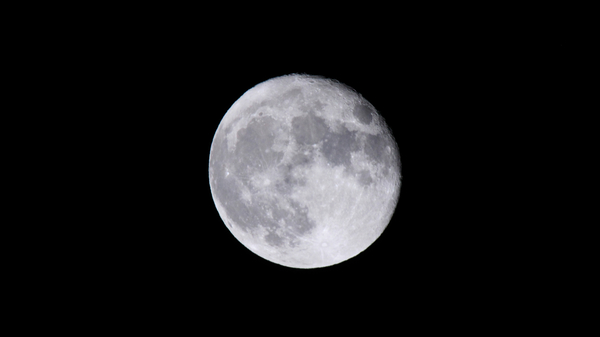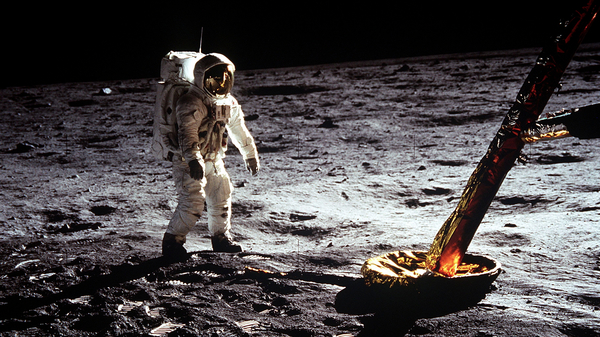The Moon: Our Satellite
There are more than 200 natural satellites, or moons, in the solar system. Ours is called, simply, “the Moon.”

The Moon is the fifth-largest natural satellite in the solar system.
©iStockphoto.com/springtime78
Skywatching tipps for July 2025
Earth to spin unusually quickly in July and August
A Brief Overview of the Moon
A natural satellite, or moon, is a small body that orbits a larger one. There are at least 200 known moons in the solar system, but most of these orbit one of the giant outer planets.
Within the solar system’s inner region, there are only three moons. Mercury and Venus have none, Earth has “the Moon”, and Mars has two small, irregularly shaped moons named Phobos and Deimos.
Our Moon is made of rock and metal—its composition is similar to the four inner planets. It has little or no atmosphere.
The lunar surface is covered in craters caused by impacts from asteroids, comets, and other space rocks. There are large dark regions that astronomers originally referred to as “seas.” Today we know they are areas of solidified lava resulting from volcanic eruptions in the Moon’s distant past.
Where Is the Moon in the Sky?
Find and track the Moon with our Interactive Night Sky Map
Check the weather in your town or city
When Is the Best Time to See the Moon?
After the Sun, the Moon is the second brightest object in our sky. The Sun and the Moon are the only astronomical bodies that can easily be seen in the daytime.
Despite being our nearest neighbor, the far side of the Moon is hidden from us. This is because, like many moons in the solar system, the Moon has synchronous rotation. It takes the same time to spin once on its axis as it does to complete one orbit around the Earth.
In other words, the near side of the Moon always faces toward Earth, while the far side always faces away. In practice, only 41 percent of the lunar surface is totally hidden because the Moon wobbles a little in its orbit. This is called libration.
As the Moon orbits the Earth, it shows phases as its position changes in relation to the Sun. Every phase offers a good opportunity to observe the Moon. The Full Moon is perhaps the most celebrated phase, closely followed by the slender Waxing Crescent and Waning Crescent phases.
The First Quarter and Third Quarter phases are the best time to see the Moon in the blue daytime sky. The New Moon phase is known as the invisible phase, but, occasionally, it can produce one of the most dramatic spectacles in astronomy: a solar eclipse.
Is the Moon upside-down in the other hemisphere?
Next Full Moon
Jul 10, 2025 at 4:36 pm
Previous Full Moon
Jun 11, 2025 at 3:43 am
Times for the Full Moon vary by time zone. Times and dates are based on the local time in Columbus. Change location

A Full Moon we can never see from Earth. The right half of this image shows the near side of the Moon; the left half shows the far side. This photo was taken by the Galileo spacecraft as it passed by on its way to Jupiter in December 1990.
©iStockphoto.com/NASA/JPL
How Long Is a Day?
The Moon takes about 27.32 days to rotate once on its axis. This is called a sidereal day. The Moon’s synchronous rotation means this is also the time it takes to complete one Earth orbit.
For an observer standing on the Moon’s surface, however, it takes roughly 29.53 days for the Sun to appear in the same position in the sky. This is a solar day. It’s different from the sidereal day because Earth and the Moon are themselves moving around the Sun.
For observers on Earth, 27.32 days and 29.53 days correspond to the sidereal and synodic lunar months.
Does the Moon Have Any Moons?
The Moon has no natural satellites itself. As far as astronomers are aware, none of the moons in the solar system have their own moons.

To date, 12 humans have walked on the Moon. This is Buzz Aldrin, as photographed by Neil Armstrong.
©NASA/JPL-Caltech
Human Exploration of the Moon
On September 13, 1959—less than two years after the start of the space age—Luna 2 became the first spacecraft to hit the Moon. It was traveling at about 3.3 kilometers per second (around 7400 miles per hour) when it struck the lunar surface.
The following month, on October 7, 1959, the Luna 3 spacecraft took the first photographs of the Moon’s far side. The first humans to see the far side for themselves were the three astronauts on board Apollo 8, which went into lunar orbit on December 24, 1968.
The most famous date in the history of lunar exploration is July 20, 1969. This was when the Apollo 11 astronauts Neil Armstrong and Buzz Aldrin became the first humans to set foot on Earth’s natural satellite. The date was July 20 for time zones in the United States and July 21 in UTC time.
Where did Apollo 11 land on the Moon?
The first soft, controlled landing by a spacecraft on the far side of the Moon did not take place until January 3, 2019. The Chang’e 4 mission included a lunar lander and rover.
Sleep, crime, and menstruation: how the Moon affects humans
How Long Does It Take to Get to the Moon?
It takes a few days to reach the Moon. Luna 2 flew directly from Earth to the Moon, and arrived in less than two days.
Apollo 11 took a little longer. It spent a short time in Earth orbit before heading to the Moon. It then slowed and went into orbit around the Moon, before the lunar module detached from the command module and began its descent to the surface.
Chang’e 4, meanwhile, spent 22 days in lunar orbit before beginning its descent to the far side.
Luna 2
- Launched: September 12, 1959, 06:39 GMT*
- Arrived: September 13, 1959, 21:02 GMT (impacted)
- Journey time: 1 day and 14 hours
Apollo 11
- Launched: July 16, 1969, 13:32 UTC
- Arrived: July 21, 1969, 02:56 UTC (Armstrong’s first step)
- Journey time: 4 days and 13 hours
Chang’e 4
- Launched: December 7, 2018, 18:23 UTC
- Arrived: January 3, 2019, 02:26 UTC (landed)
- Journey time: 26 days and 8 hours
* GMT was the world’s time standard until 1961.